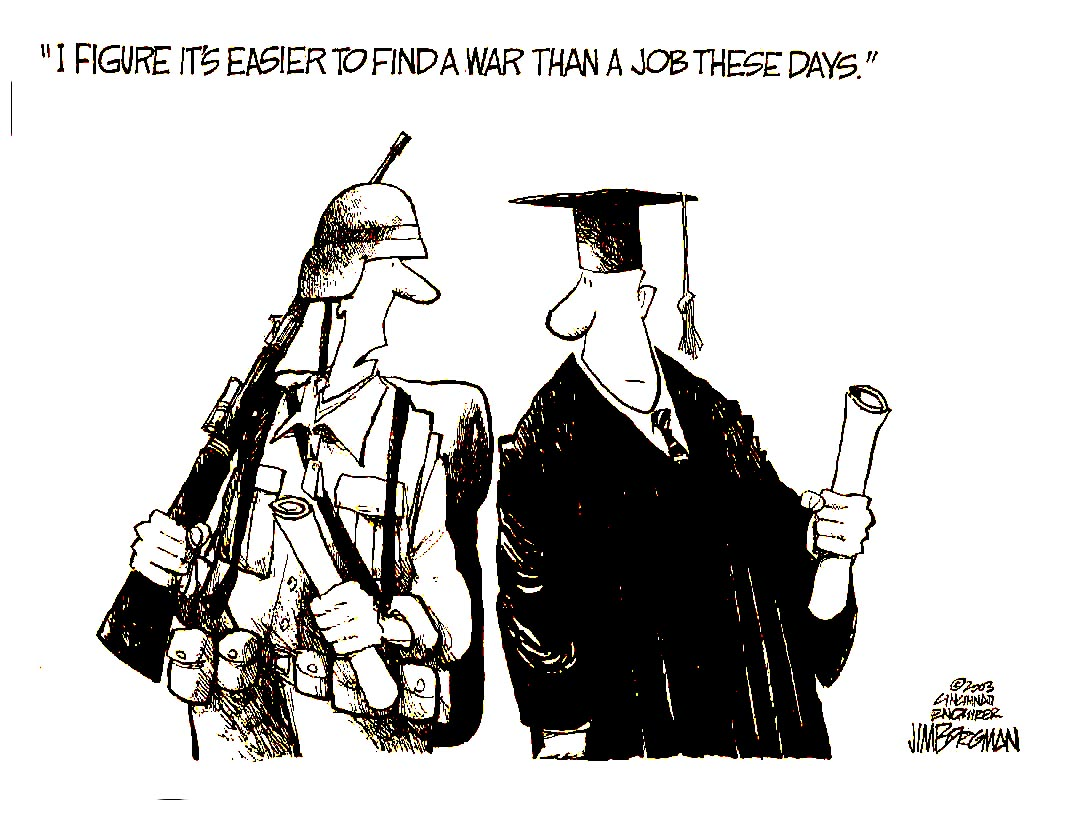The political cartoon drawn by Jim Borgman eloquently illustrates the problems faced by many young American people nowadays. In particular, it shows that they often do not have any employment opportunities, and some may be forced to join the Army hoping that it can create at least some opportunities for them.
Apart from that, this image can be aimed at criticizing the policies of the government that attaches more importance to military spending, rather than economic development of the country and welfare of its citizens. These are the main argument that the cartoonist puts forward.
By using both imagery and verbal elements, Borgman succeeds in making a very powerful statement about the life contemporary society in which the feeling of insecurity is probably the most dominant one. The key topic that the author explores is the lack of opportunities for American people, especially those ones who are relatively young. This cartoon was created in 2003 at the time when economic problems began to manifest themselves, and the country was conducting several military operations abroad.
Yet, nowadays when the impacts of recession have not been fully overcome, this issue is even more important for a greater number of people, namely school and college graduates. They may not always be able to achieve success in their social life. The audience of this cartoon is difficult to define, because it can include every person who is interested in the political, social, and economic life of the country.
Yet, one cannot say that there are distinct demographic characteristics of the audience. Overall, it is possible to argue that Jim Borgman supports left-wing ideology which emphasizes the necessity for social change and egalitarian relations in the society. This cartoonist is extremely concerned with future development of American society.
This cartoon is a single-frame image in which the author depicts two characters; one of them is a soldier holding an assault rifle, while the other one is probably a college graduate. It should be noted that Jim Borgman does not portray their faces in much detail. One can only see that these are male characters.

Overall, one can argue that this cartoon is quite realistic, especially as far as clothing of the characters is concerned. This description is supposed to show that these people represent two different social classes. One of them is a former student who is holding either his diploma or resume while the other person is a young man who preferred military career. They have to represent different options that are available to young people in the contemporary United States. In particular, some of them may choose to get education while other may prefer the Army as a way of climbing social ladder. The main issue is that none of these options can guarantee success to a person.
The author relies on both word and image. The most important element is the textual message included into this cartoon. In particular, the soldier says, “I figure it’s easier to find a war than a job these days”. To a great extent, this sentence can be viewed as a title of the cartoon. This statement shows how difficult it is for a person find ones niche in the contemporary workforce. This is the most obvious argument that this image contains.
Jim Borgman’s tone is both comic and serious at the same time because the author portrays characters in a caricatural way, but this image also makes a viewer feel empathy of these people. The author does not refer to any particular person or specific event, but one can understand that the author describes the life of contemporary Americans. Apart from that, it is possible to see a hidden or implied message in this cartoon. To a great extent, it is aimed at showing that the government is too concerned with military strength of the country, but not much attention is being paid to the economic welfare of citizens.
As a result, college graduates are often unable to find a job that can best suits their talents and education. Overall, Jim Borgman has been able to show the sense of insecurity that these people experience. To some degree, this situation can be explained by the policies and strategies of the state. Thus, one can say that Jim Borgman can make several rhetorical statements with the help of this cartoon. Although the author does not calls for a specific change, he skillfully shows that current situation leaves much to be desired.
On the whole, the image drawn by Jim Borgman is excellent example of how visual and verbal messages can convey a deep rhetorical argument that can pose many thought-provoking questions to a person. The cartoonist relies on both visual and verbal elements in order to express his argument. Through this cartoon, the author highlights some of the most important problems that can be encountered by young people. So, this image can be regarded as an excellent example of a political cartoon.
Bibliography
Borgman, Jim. I figure it’s easier to find a war than a job these days. Cartoon. 2003. Web.
Hess Stephen and Sandy Northrop. American Political Cartoons: The Evolution of a National Identity, 1754-2010. New York: Transaction Publishers, 2010.